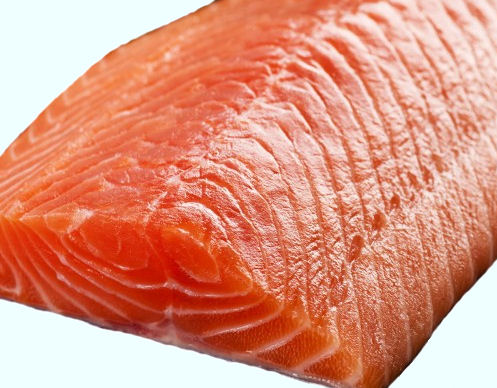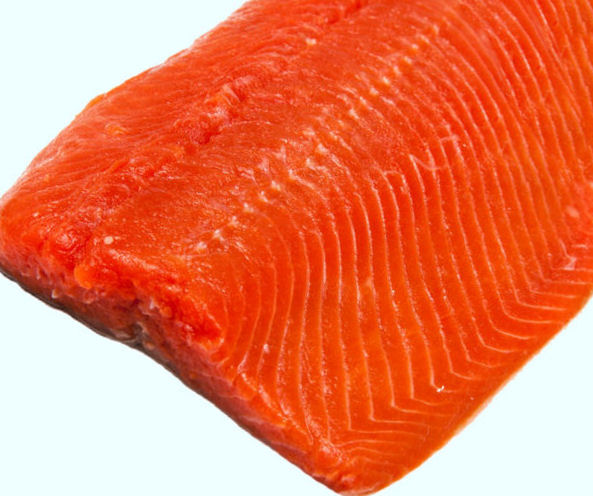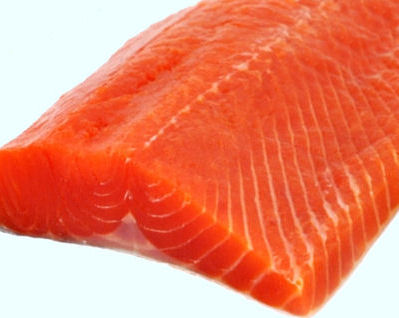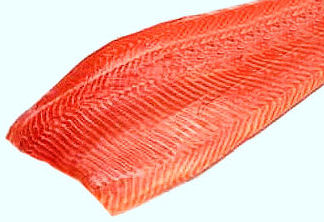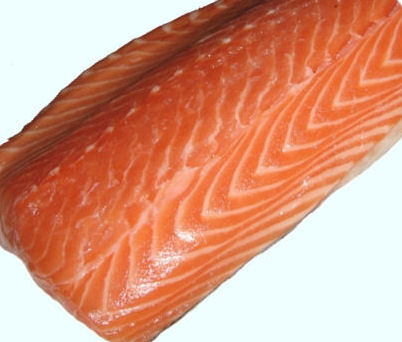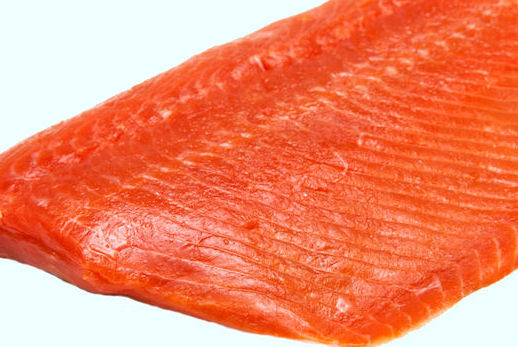
Fishing Recipes, Cooking and buying tips, Nutrition facts, How to smoke fish, salmon on a grill, Salmon Lox, Tuna tartare.
The majority of you aspire to eat healthy, pure, and organic food. These qualities are found in seafood. Especially in fish, which are found in salty waters of ocean, deep-water fishes (usually flat shaped), and the mountain rivers' fish. Fish oils are beneficial to us and fish is a valuable source of low fat protein and minerals essential to human health. Fish is quick to cook, easy to digest and tastes good.
The great number of the methods exists of the preparation of fish. Some types of fish better fried, other have best taste, being boiled, some perfect for hot on grill, other own elegant taste, being smoked. Generally case, shallow fish better fried and large boiled. Fish with a great many fat, of the type of salmon and blackhead, is excellent for grill and smoke, but the same processes used with not fat fish, do it's dry and rigid.
Remember: Fish like to swim three times – in the water, in butter and in the wine.
If you ate pasta and antipasta, would you still be hungry?

- Mummy! Can you hear over the phone how the cutlets are hissing? What do you think - How much longer they need to be fried before they are ready?
Two girlfriends:
- "Well and how was the first dinner you cooked for your husband?"
- "Not bad, tomorrow he will be out of the hospital..."
In the hospital
- What kind of dreadful medicine have you brought me?!
- What medicine?! It's your dinner!!!
Maple Salmon
Grilled Salmon
Salmon Shish Kebab
Lox - Cured Salmon
Tuna Tartare
Types of Salmon
How to Smoke Salmon?
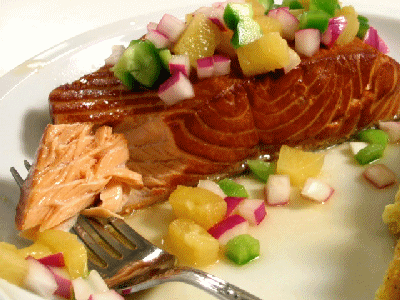
- Prepare brine
- Cure fish
- Air dry fish
- Smoke fish
- Eat smoked fish
Preparing the brine
It's what makes smoked salmon so good! Salmon Brine! This magical liquid reacts with the flesh of the fish, changing its structure. That change, in turn, improves the texture and helps the fish retain moisture. Basic fish brine is:
- 4 cups water
- 1/4 cup kosher salt
- 1/4 cup brown sugar
- 2 bay leaves
- 1 stalk sliced celery
- 1/2 cup chopped fennel
- 1/2 chopped onion
- 2 smashed garlic cloves
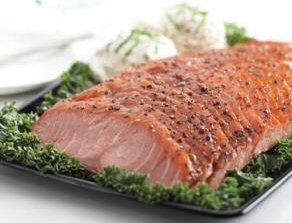
Mix together all the ingredients and place your fish in a non-reactive container (plastic or glass), cover and put in the refrigerator.
Curing the Fish
You need to cure fish for at least 8 hours, even for thin fillets. For thick salmon fillet it is better to do for at least a day. For sturgeon steaks or something even thicker, it could be for two days.
Don't worry, you can not overdo it. The longer you keep it in the brine, the saltier it will get.
You need to do it to eliminate some of the moisture from the inside of the fish while at the same time infusing it with salt, which will help preserve the fish.
Air Drying the Fish
You do this by resting the brined fish on a rack and putting it in a cool (less than 65 degrees) place that has good air circulation, or you can run a fan over the fish at low speed.
Let the fish dry this way for at least 2 hours, and up to three. Don't worry! The salt in the brine will protect your fish.
You do this to form a thin, lacquer-like layer on top of the fish that seals it and offers a sticky surface for the smoke to adhere to (called a pellicle). This is the step many smokers fail to do, but drying your cured, brined fish in a cool, breezy place is vital to properly smoking it.
Once the pellicle is formed on the surface of the salmon, it's time to smoke.
Smoking the Fish
I smoke my fish at around 150 - 180 degrees at the most, usualy use hickory, apple, oak or any other fruit or nut wood.
How long? Depends on temperature and how thin is your fish. Usually from 1 to 2 hours, 4 hours for a realy thick steaks and you get the best tasty fish ever.
Back to top
Maple Salmon
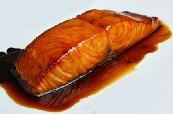
- 1 pound salmon
- 1/4 cup maple syrup
- 2 tablespoons soy sauce
- 1 clove garlic, minced
- 1/4 teaspoon garlic salt
- 1/8 teaspoon ground black pepper
1. Mix the maple syrup, soy sauce, garlic, garlic salt, and pepper in a small bowl.
2. In a shallow glass baking dish coat he salmon with the maple syrup mixture. Cover the dish, and marinate salmon in the refrigerator 30 minutes, turning once.
3. Preheat oven to 400 degrees F (200 degrees C).
4. Place the baking dish in the preheated oven, and bake salmon uncovered 20 minutes, or until easily flaked with a fork. Enjoy it.
Back to top
Grilled Salmon
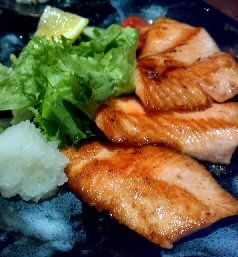
Prepare sauce for a salmon
Bring 1/2 cup dry white wine to a simmer in a small saucepan. Stir in 1/2 container herb and garlic cream cheese, Alouette, Pub Cheese or Boursin. Stir constantly until melted and smooth. Taste. If desired, add more cheese or wine to taste. If you don't like wine, you can use a milk instead.
Preheat the grill to medium-high, lightly oil the grill rack, cook the fish until opaque, turning once during cooking. This will not take long, about 8 to 10 minutes, so watch it carefully, don't let the fish dry. Make sure that no flame touches the fish directly.
For an alternative preparation, make large rectangles of aluminum foil and center a filet in each one. Sprinkle with lemon juice, garlic, salt, pepper and dill. Fold foil tightly and grill salmon for 10 minutes over medium heat in the pouch. Enjoy it.
Back to top
Salmon Shish Kebab
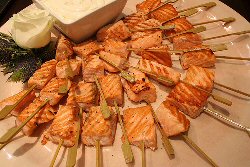
- 2 lbs. Salmon ( also could be Swordfish, Chilean Seabass, Halibut)
- 3/4 cup lemon juice
- 1/3 cup olive oil
- 1 teaspoon dill
- 1 tablespoon vinegar (white)
- 1 pint cherry tomatoes
- 1 medium cucumber
- 1 onion
- 2 red peppers
1. Mix olive oil, lemon juice, dill, and vinegar to make marinade.
2. 2 hours prior to grilling, prepare fish by rinsing with cold water. Pat dry with paper towel. Cut into 1 inch cubes. Set aside.
3. Pour marinade into large freezer bag and add fish. Make sure fish is well covered by marinade. Place in the refrigerator for two hours.
4. Chop vegetables. Half the cucumber lengthwise and slice into 1/2 inch pieces. Cut the onions into eights. Cut red pepper into 1/3 chunks. Set aside.
5. Remove fish from marinade. and sssemble kebabs according to taste. I personally like to do a vegetable them meat combination. But this is entirely a matter of personal choice. It really does not affect the cooking. If you are using steel skewers, be sure to put a light coat of oil before adding the fish and vegetables. They will slide off much easier.
6. Spray the grill lightly with cooking oil and place the fish kebabs on the grill. Cook for about 4-6 minutes each side or until the fish flakes easily with a fork. Enjoy it.
Back to top
Lox - Cured Salmon
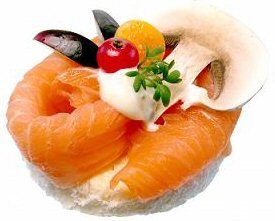
- 2 filets of Salmon (middle pieces)
- Kosher Salt
- Sugar
- Pepper (optional)
- Dill (optional)
1. Prepare the salt-sugar-mix in the following proportions: 2 tablespoon of Salt and 1 tablespoon of Sugar. Make a mixture as much as needed to cover the fish filets. Add a little pepper. I usualy add 1/2 of teaspoon pepper with 6 tablespoon of Salt and 3 tablespoon of Sugar.
2. Cut the salmon in 2 filets remove the bone but keep the skin. Dry the pieces with some kitchen paper.
3. Chop the dill.
In a dish large enough to accommodate the salmon, sprinkle the bottom with some of the salt-sugar-mix, and some of the dill. Place one piece of fish, skin-side down, on the mixture. Sprinkle nearly all of the mix and dill on the fish, and place the other piece on top, skin-side up. And put rest of the salt mix and dill on top.
4. Cover the dish and refrigerate for 2 days. Turn it around every 12 - 24 hours.
The longer the fish cures, the more water will be extracted from it, and the firmer and less raw it will be. 2 days is pretty much enough. The fish will water lots during the curing; this is normal.
5. Once the fish has cured, pick it out, brush it and place in the large container with cold water. I usualy do it for 2 hours with changing the water every 1/2 an hour. As to stating of some adepts, fish must be in a water as much time, how many days resided in brine. This process will take a little salt out of the fish and lox will be less salty and more tasty.
Ones again Dill and pepper are optional, as well as keep fish in the water after cure. Enjoy.
Back to top
Tuna Tartare
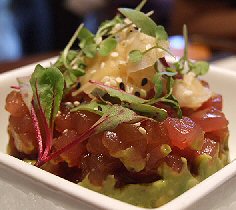
- 10 oz. of Sushi/Sashimi grade tuna
- 3 Tablespoons of Japanese Mayonnaise
- 1 1/2 Tablespoons of Japanese Chili Pepper Mix (S&B Nanami Togarashi)
- 1/2 Tablespoon of black toasted sesame seeds
- 1/2 Tablespoon of toasted white sesame seeds
- 1/4 Tablespoon of orange peel
- 1 Tablespoon of shredded dried seaweed (nori)
- 1/2 Tablespoon of very finely chopped dried ginger or grated fresh ginger (whatever you have on hand)
- 1 Tablespoon of chili pepper (very fine)
- 1 large Kirby or Israeli cucumber, peeled, seeded
- 4 Tablespoons of marinated green seaweed salad
- 1 head of endive lettuce
or if you do not have this mix use the spices below:
1. Cut up the tuna into small cubes about 1/4 of an inch all around.
2. Chop the cucumber into julienne slices and then chop into small pieces. Lay cucumber on paper towel for 15 min to drain all the liquid.
3. Place the tuna and drained, dried cucumber into a metal mixing bowl, add the mayonnaise, spice mixture and seaweed and mix very gently with a metal spoon until thoroughly combined. Be careful not to break apart the pieces of tuna.
4. Marinate the tuna for about 45 min in the fridge (NO LONGER) or the tuna will start to lose its color.
5. Wash lettuce and remove stem, pull apart the individual endive leaves and place in a flower format around a dark plate. Place a small amount of tuna salad in the middle for presentation and then spoon a small amount (about 1 tablespoon) on each leaf.
6. You can use a touch of finely chopped dried seaweed salad on top of each endive leaf with tuna as a garnish.
Back to top
/p>
Types of Salmon
When shopping for fish for the grill or smoker, it good to know about the different types of salmon. Salmon is anadromous, meaning that it spawns in fresh water. Some fish become landlocked in lakes, resulting in a supply of freshwater salmon, which is considered to be not as flavorful, and therefore not as prized, as saltwater salmon. Each species has certain qualities that affect its flavor and cooking characteristics. The oil level in the flesh of the salmon varies from species to species, but the location from which the fish is harvested also has an affect on the quality. Types of salmon that are low in oil content are usually lower in price. When these fish are marinated or seasoned with herbs and spices, they can be good eating. Knowing a little about the different types of salmon will help you choose the best cooking method when grilling or smoking.
When absolutely fresh, raw salmon is delicious. It is also excellent grilled, broiled, poached, baked, roasted, and sauteed. If grilling or broiling, better to choose one of the fattier varieties (like Atlantic or Chinook salmon), which are not as easy to overcook. The silvery skin of the salmon is very tasty when grilling whole salmon, brush the skin generously with oil to help keep it intact. When you buying a salmon, fresh or thawed steaks and fillets should look moist and smell seawater fresh flesh should glisten. Whole fish should look alive and be well iced. Make sure salmon's skin looks bright, shimmery, and fresh.
Nutrition Value: Salmon is an excellent source of protein (39g), vitamin A, B vitamins, and Omega-3 oils.
When cooked, dry heat, 1/2 fillet (5.4 oz. / 153g) of Salmon contains 280 Calories, 12.5g Total Fat, 0.0g of Carbohydrate and Fiber, 967mg of Potassium, 72mcg of Selenium, 15.5mg of Niacin and 57mg of Magnesium.
When cooked, dry heat, Atlantic wild salmon per 100 grams provides 2.218 grams of omega-3 fatty acids, derived from 0.411g of Eicosapentaenoic Acid (EPA), 1.429g of Docosahexaenoic Acid (DHA) and 0.378g of Alpha Lipoic Acid (ALA). When cooked, dry heat, Atlantic farmed salmon per 100 grams provides 2.26 grams of omega-3 fatty acids, derived from 0.69g of Eicosapentaenoic Acid (EPA), 1.457g of Docosahexaenoic Acid (DHA) and 0.113g of Alpha Lipoic Acid (ALA).
Pacific Salmon Pacific salmon is a term that can be used for any one of five species of salmon, all found in the Pacific Ocean. These salmon include chinook, sockeye, coho, pink and chum salmon.
Chinook SalmonWhen cooked, dry heat, Chinook salmon per 100 grams provides 1.847 grams of omega-3 fatty acids, derived from 1.01g of Eicosapentaenoic Acid (EPA), 0.727g of Docosahexaenoic Acid (DHA) and 0.11g of Alpha Lipoic Acid (ALA).
When cooked, dry heat, Sockeye salmon per 100 grams provides 1.292 grams of omega-3 fatty acids, derived from 0.53g of Eicosapentaenoic Acid (EPA), 0.7g of Docosahexaenoic Acid (DHA) and 0.062g of Alpha Lipoic Acid (ALA).
When cooked, dry heat, Coho salmon per 100 grams provides 1.114 grams of omega-3 fatty acids, derived from 0.401g of Eicosapentaenoic Acid (EPA), 0.658g of Docosahexaenoic Acid (DHA) and 0.055g of Alpha Lipoic Acid (ALA).
When cooked, dry heat, Pink salmon per 100 grams provides 1.332 grams of omega-3 fatty acids, derived from 0.537g of Eicosapentaenoic Acid (EPA), 0.751g of Docosahexaenoic Acid (DHA) and 0.044g of Alpha Lipoic Acid (ALA).
When cooked, dry heat, Chum salmon per 100 grams provides 0.848 grams of omega-3 fatty acids from 0.299g of Eicosapentaenoic Acid (EPA), 0.505g of Docosahexaenoic Acid (DHA) and 0.044g of Alpha Lipoic Acid (ALA).
Back to top



